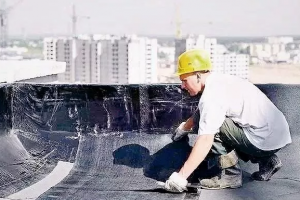Common phenomena and solutions of roof waterproofing membrane leakage
date: 2020-02-05 19:03:07Source: RG JIAYEViews: 2325

- Stripping of asphalt linoleum coil waterproof material and bonding layer
Phenomenon: The peeling of the asphalt linoleum waterproofing membrane from the base layer will seriously affect the waterproof quality, causing the membrane to sag, the end to fall off, rain invasion, and leakage.Reason: Most of the situations of asphalt linoleum waterproofing membranes are because the leveling layer and the quality of the base layer are not controlled (such as the quality of the leveling layer is not good enough, it is not sufficiently dry and easy to sand; the surface of the base layer is uneven); or ordinary waterproof The quality of the coil itself is unqualified; or due to the low construction temperature of the hot glue and self-adhesive coil, the waterproof layer and the base layer are not firmly bonded and peel off.
Solution:
① In a small range of roofing, it is generally possible to cut the waterproof layer and then dry it. After it is dry, apply adhesive again to paste it, and then paste a strip of 300mm wide at the slit.② On large-slope roofs, mechanical fixing methods can be used for processing. Generally, nails or strips are used to nail the peeling of ordinary waterproof coiled material, and then the sealing material is sealed on the nails (if steel strips are used, the steel strips must be rust-proofed).
③ The joints between the roof and the wall, or the structure protruding from the roof are usually overlapped. Usually, after the waterproof layer is cut, the facade waterproof membrane is turned up, the leveling layer is cleaned, and a layer is applied with full adhesion. The waterproof membrane is bonded to the horizontal waterproof membrane, and then the facade waterproof membrane is turned down and pasted again. The overlap width of the membrane should be greater than 150mm.
2. The “drum bag” of waterproof membrane
Reason: The bulging of the asphalt linoleum waterproofing membrane often occurs in actual engineering. Generally, it is relatively easy to occur in the following two cases: one is that the indoor vapor penetrates through the structural layer to the bottom surface of the ordinary waterproofing membrane; the other is that a certain amount of water vapor is left in the insulation layer or the screed layer, and the water vapor evaporates Or bulging makes common waterproof membranes bulge. Drum kits generally develop from small to large starting from the bottom coil. Some sizes of drum kits are connected in series, with a large diameter of 200 to 300 mm and a local bulge of 50 to 80 mm.Solution: For the leaking of the asphalt linoleum waterproofing membrane, generally different treatment methods can be adopted according to the size and severity of the “bulging”.
When the diameter of the “drum bag” is small (generally refers to the diameter of the drum bag is less than 80mm), it is usually treated by suction irrigation. Specific method: Drill two small holes on both sides of the bulge. One hole uses a syringe to draw out the air in the bulge, and the other hole uses a syringe to inject the adhesive, and then presses it hard to make it the base layer of the ordinary waterproof membrane. Strong bonding. Finally, seal the two pinholes with sealing material. When the diameter of the “bulb” is large, the “bulb” is generally cut off and repaired.
3. Cracking of the coil waterproof layer
Reasons: The main reasons for the cracking of the coiled material are: the leveling layer has low strength and poor quality; the area of the roof is large, and the setting of the sub-slots is unreasonable;The dry and wet mortar screed layer causes cracking; and the erratic ambient temperature changes cause cracking of the concrete or mortar cracking.
Solution: For the repair of cracks in waterproof membranes, the repair method is also selected according to the degree of damage in actual engineering. For example, when the damage degree of the waterproof layer of the roof is small and the area is small, the jointing method of the sealing material can be used. The usual method is to first cut off the 50mm wide leveling layer on each side of the crack of the waterproof layer of the coil, the depth direction is greater than 30mm, and then heat the polyvinyl chloride. It is also 3mm above the roof.
In the case of serious damage to the roof waterproofing membrane, it is generally necessary to reset the waterproof layer. Before resetting the waterproof layer, the construction party is usually required to add an additional reinforcement layer during the construction. The “Technical Specifications of Roof Engineering” also mentions that when the roof is waterproof An additional reinforcement layer must be provided (during the waterproofing process, due to stress concentration and frequent deformation in some locations, severe rain erosion or external force damage, local damage will occur earlier, resulting in the entire waterproofing layer needing to be repaired before it reaches the end of its durability. In this case, a reinforcing layer is provided on the weak part that is liable to cause local damage to improve the overall defense ability of the waterproof layer and extend the service life of the entire waterproof layer).
The specific method of the roofing membrane waterproof reinforcement layer is: Generally, a polymer coil with a width of 200 to 300 mm and a thickness of 1.2 mm or a modified asphalt coil with a thickness of 3 mm is used to stick a single edge to the end of the roof panel or use pressure Sensitive adhesive, and finally lay a large area waterproof layer.








